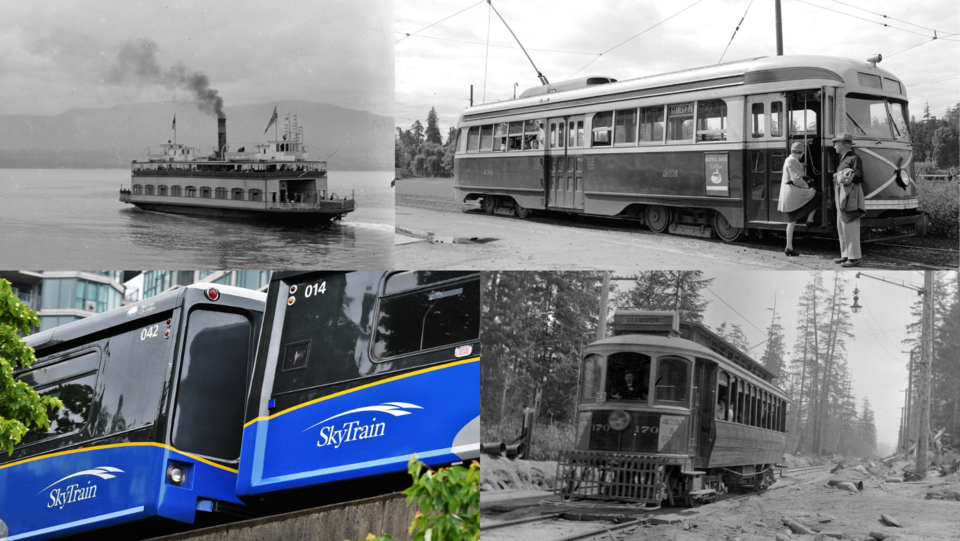For more than 120 years, public transit has helped get people around Vancouver.
Before cars were a common sight on the roads and when the horse-and-buggy still dominated the streets, streetcars came to Vancouver. Since then, the system has morphed and grown to help move even more people about the region.
Over that time there have been lots of "did you know" moments, and we've collected a few that are hopefully obscure enough for you to say "I didn't know that!"
1. The early Vancouver transit companies also ran the lights
To be fair, electric lighting was new and sparse in 1890s Vancouver, so the company didn't run too many lights, but they made sure they were lit all the same.
At the time the company was the Vancouver Electric Railway and Light Company (VERLC), after a merger of two specialized companies before municipal rail really started. That only lasted a few years before VERLC failed and was lumped together with the failing Victoria and New Westminster rail and light companies to become the Consolidated Railway Company. Then it failed.
The BC Electric Railway Company was then founded and the two different electrically powered services drifted apart.
2. Trolley bus drivers didn't need licenses until 1973
First, let's explain that Vancouver has an extensive trolley bus system; those are the ones hooked on wires fuelled by electricity. TransLink has more than 260 in Vancouver.
And, until 1973, you didn't need a licence to drive one, even though 1970s traffic in Vancouver was a serious thing.
This was because they were replacements for the old streetcars that ran on rails. Since they didn't have their own fuel source, they were considered rail vehicles (despite having rubber tires and driving on roadways). Regulations changed and all current trolley bus drivers have licences.
3. The heat dome was so hot it slowed the SkyTrain
One of the metrics by which TransLink measures its success is through on-time performance (OTP); it's essentially the per cent of the time transit is on time. The target is 96.5 per cent, which the SkyTrain achieved for 15 straight months starting in March 2020. That ended in June of 2021.
What broke that streak?
"June’s on-time performance was affected by the extreme heat experienced at the end of the month," said TransLink in a 2021 report. "One mitigation step taken that affected OTP was slowing down train speeds due to high running rail temperatures. Lowering train speed limits how much heat is transferred from train to rail."
That's right, the rails were getting too hot, which is a seriously bad thing.
June was bumped down to 95.2 per cent, which isn't bad, but let's remember that the heat dome only occurred at the end of the month; the majority of the month it was operating at, or above, the standard.
4. Vancouver's transit system held a few records, but they're dwindling
At one time, Vancouver's transit system held two world records. The SkyTrain system was the world's only (at first) and largest driver-less system for decades but has recently been overtaken by several Asian cities (and no, the Broadway extension won't help Vancouver retake first).
At the same time, the bridge between New Westminster and Surrey, the Skybridge, was the world's longest cable-supported transit-only bridge (also, fun fact, it was built in part by Hyundai, the same company that puts things like Elantras and, before that, Ponys on the road). The Skybridge is 616 metres long; from its construction until 2019 that was good enough for the record, until Chongqing built a bigger one.
There's at least one more record held by Vancouver's transit system: The 99-B line is the busiest bus route in Canada and the U.S. However, that record has a clock on it as the Broadway subway line is being built for that exact reason.
5. One of the precursors to the SeaBus became a North Vancouver eatery until it had to be literally scrapped
Metro Vancouver's SeaBus is maybe the most fun part of the region's transit system. Little public passenger boats are an uncommon sight in most urban settings; sure, there are harbour ferries all over the place, but few are an essential piece of commuter infrastructure.
Ferries of some sort have long been crossing the Burrard Inlet (except for a period through the 1960s when the bridges were enough).
One of the five craft (Ferry No. 5) that crossed through the 1940s and 50s ended service in 1958 and was quickly turned into a restaurant floating on the water off North Vancouver. Service continued for 40 years (more than double its time as a ferry) until it shuttered in 2001. The ship was scrapped in 2002.
Have any other fun transit facts? Email [email protected]




